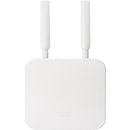Description
Meet the Meraki MG21E Cloud Managed Cellular Gateway with External Antennas for North America. This enterprise-grade gateway delivers a robust, cloud-managed cellular uplink that can serve as a reliable backup when your primary Internet connection falters, or even as a primary WAN in environments where fixed broadband isn’t feasible. Designed to sit seamlessly within the Meraki ecosystem, the MG21E brings enterprise-grade reliability, streamlined deployment, and centralized visibility to networks of all sizes. Whether you’re running a distributed office footprint, a remote site, or a campus with fluctuating connectivity, the MG21E helps you stay connected, productive, and secure with zero-touch provisioning, intelligent failover, and proactive monitoring via the Meraki Dashboard. The North America focus and external antennas are optimized to maximize coverage in a wide range of environments, from urban campuses to remote facilities.
- Cloud-managed efficiency across the Meraki ecosystem: The MG21E is designed to sit alongside Meraki access points, switches, and security appliances in a single, cloud-managed environment. With the Meraki Dashboard, IT teams gain a consistent configuration template, automatic policy propagation, and real-time visibility across all sites, simplifying large-scale deployments and ongoing operations.
- Automatic WAN failover for business continuity: When a primary uplink—fiber, cable, or DSL—degrades or goes offline, the MG21E automatically routes traffic over the cellular network. This intelligent failover minimizes downtime, protects critical applications, and reduces the risk of productivity loss from a single point of failure. Flexible failover policies let you tailor how and when traffic shifts between uplinks to suit your network’s performance needs.
- Resilient, multi-carrier cellular connectivity: Built for sites where fixed broadband isn’t available or practical, the MG21E leverages cellular networks to provide a dependable uplink. You can configure SIM profiles to switch between carriers or deploy multiple SIMs for redundancy, ensuring connectivity even in areas with spotty service. This is ideal for remote offices, field operations, or campuses that demand always-on access.
- Enterprise-grade security, policy control, and visibility: The MG21E inherits Meraki’s security model, delivering centralized policy management, scalable firewall rules, VPN capabilities, content filtering, and real-time traffic monitoring. Ongoing security updates and policy consistency across sites occur without on-site interventions, helping you maintain a strong security posture from the cloud.
- Zero-touch deployment and scalable management: Designed for rapid, low-effort site rollouts, the MG21E supports zero-touch provisioning. Deploy at new sites, register to the Meraki Dashboard, and push out policies and configurations from a central console, no on-site configuration required. This makes it easier to scale across a growing footprint and maintain consistent configurations everywhere.
Technical Details of MG21E
- Model: MG21E
- Type: Cloud Managed Cellular Gateway
- Region: North America
- Connectivity: Cellular gateway with external antennas
- SIM: Multi-SIM capable for redundancy and carrier flexibility
- Management: Meraki Dashboard with zero-touch provisioning
- Security: Centralized firewall, VPN, policy enforcement, and automatic security updates
- Deployment: Scales from small sites to campus-wide deployments with consistent templates
- Support: Cloud-driven monitoring, alerts, and health status across all sites
How to install MG21E
- Plan your deployment by identifying sites that will use the MG21E as primary or backup WAN, and ensure you have access to the Meraki Dashboard for zero-touch onboarding.
- Position the gateway in a secure, ventilated location with access to power and nearby cellular coverage. If possible, place the device in a central location to maximize antenna performance.
- Connect the external antennas to the MG21E and orient them for optimal signal reception. Proper antenna placement can significantly improve uplink stability and speeds, especially in areas with weak cellular coverage.
- Power on the device and confirm it establishes cloud connectivity. The MG21E will register to the Meraki Dashboard automatically through the cloud, enabling zero-touch provisioning.
- In the Meraki Dashboard, assign the MG21E to a site, apply the appropriate network policies, and configure failover settings. Validate that the cellular uplink is active and that traffic shifts in line with your configured policies. Run a connectivity test to confirm VPNs, firewall rules, and prioritized applications behave as expected.
Frequently asked questions
- What is the MG21E used for? It is a cloud-managed cellular gateway designed to provide a reliable internet uplink, either as a primary WAN in areas without stable fixed broadband or as a backup to protect business continuity through automatic failover.
- Does the MG21E support automatic WAN failover? Yes. When the primary uplink degrades or fails, the MG21E automatically routes traffic over the cellular network, with configurable policies to control how and when failover occurs.
- Can I use multiple SIMs or switch carriers? Yes. The MG21E supports multi-carrier connectivity with configurable SIM profiles, enabling automatic carrier switching or redundancy to ensure connectivity in varying conditions.
- Is zero-touch deployment available? Yes. The MG21E is designed for zero-touch provisioning through the Meraki Dashboard, enabling rapid site rollout with minimal on-site configuration and centralized management.
- What security features are included? The MG21E benefits from Meraki’s security model, including centralized policy management, firewall rules, VPN capabilities, content filtering, and ongoing security updates delivered via the cloud.
- Are external antennas included? Yes. The MG21E ships with external antennas to maximize cellular reception, coverage, and reliability across diverse North American environments.
- How is management handled? Management occurs through the Meraki Dashboard, offering a single pane of glass for provisioning, policy enforcement, health monitoring, and scalable administration across multiple sites.
Customer reviews
Showing - Of Reviews


